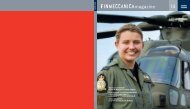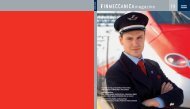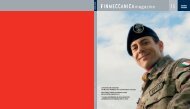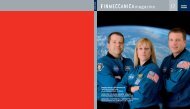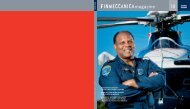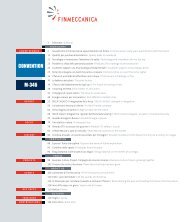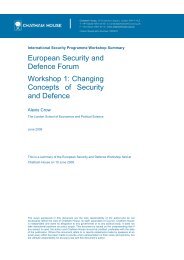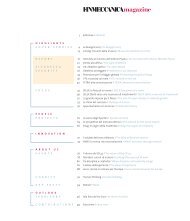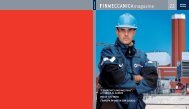E - Finmeccanica
E - Finmeccanica
E - Finmeccanica
Create successful ePaper yourself
Turn your PDF publications into a flip-book with our unique Google optimized e-Paper software.
H I G H L I G H T S<br />
9/2010<br />
FINMECCANICA MAGAZINE<br />
©NASA<br />
OUR JOURNEY<br />
FROM SPACE<br />
TO EARTH<br />
INTERVIEW WITH NICHOLAS J.M PATRICK, KATHRYN P.<br />
(KAY) HIRE AND TERRY W. VIRTS, 3 OF THE 6 CREW MEM-<br />
BERS WHO THIS PAST 8 FEBRUARY BROUGHT NODE3<br />
TRANQUILITY AND THE CUPOLA, MODULES SYNONY-<br />
MOUS WITH THE EXCELLENCE OF MADE IN ITALY, TO THE<br />
INTERNATIONAL SPACE STATION<br />
From space to Turin, or Rome... 3<br />
of the 6 American astronauts<br />
from NASA who this past 8 February<br />
brought Node3 Tranquility and<br />
the Cupola to the International<br />
Space Station came to Italy to meet<br />
in person the people and technology<br />
that made it possible for them to<br />
successfully carry out their mission.<br />
Listening to them tell the story of<br />
their daily lives in space is a truly<br />
unique experience, even more so<br />
considering that Nicholas J.M<br />
Patrick, Kathryn P. (Kay) Hire and Terry<br />
W. Virts became full-fledged protagonists<br />
in the history of space exploration<br />
with this mission.<br />
we were going to try to go to Test-Pilot<br />
School to see if I could be an astronaut.<br />
So that was... when we decided<br />
that, it was about 1997, I think.<br />
What is the image from space that<br />
you hold most dearly?<br />
Nicholas: Definitely the view from<br />
the Cupola. I was getting out of my<br />
EVA suit and Terry said “Nick come on<br />
©NASA<br />
over and take a look at this fantastic<br />
view!” I looked outside and couldn’t<br />
believe my eyes.<br />
Terry: The Cupola with its 7 portholes<br />
pointed towards Earth that offered<br />
us a panoramic view that we had<br />
never before seen in space.<br />
How does technology help you deal<br />
with the ‘daily routine’ up in space?<br />
T: There are lots of different problems<br />
that we have to solve in space<br />
and some of them we solve with<br />
very basic things that we have here<br />
on Earth and then other ones require<br />
higher technology, ‘space age stuff’.<br />
We moved our Tranquility module<br />
and our Cupola and several other<br />
modules with the robotic arm using<br />
some advanced software that use<br />
computer graphics to show a virtual<br />
world where the Space Station is. It<br />
helps us to make sure that everything<br />
is clear when we are moving it<br />
around. And then, on the other hand,<br />
we did a lot of work inside and outside<br />
that just required basic mechanic<br />
skills. We were like auto-mechanics<br />
in space.<br />
You trained for a long time. What is<br />
the reality of dealing with microgravity?<br />
N: The one thing for which we can’t<br />
really train very well is micro-gravity.<br />
And, the reality is that it is much<br />
more difficult than you would expect.<br />
You don’t have to use muscles<br />
to hold yourself, you can just hold on<br />
very gently with fingertips and occasionally<br />
let go. The problem is that<br />
the things you need – and we need a<br />
lot of things to do our work in space<br />
– tend to float away unless you put<br />
them in a pocket (where you forget<br />
them) or grid them to a wall. A<br />
screwdriver behind your head, a<br />
flashlight inside the back of your<br />
shirt. Things just disappear and then<br />
reappear all of a sudden.<br />
What is the most comfortable place<br />
on the ISS?<br />
T: Oh, that’s a good question. There<br />
are a lot of nice places on the station<br />
and each place has its own flavor. It’s<br />
not like it’s all the same. Every room<br />
is different. Undoubtedly the European<br />
lab in Columbus, built by<br />
Thales Alenia Space here in Turin,<br />
was my favorite place to sleep. Node-<br />
3 was very comfortable also because<br />
it was new and there wasn’t very<br />
much stuff in there, it was not<br />
crowded. At any rate, sleeping in<br />
space doesn’t have to be the same as<br />
in your own bed…<br />
N: The way we sleep in space is we<br />
use a sleeping bag and we likely tie<br />
down the sleeping bag to whatever<br />
surface you want to hold it against.<br />
You could use the floor, the wall. I<br />
When did you actually decide that<br />
this would become your job, to be an<br />
astronaut?<br />
Terry: Well, when I was a little kid, is<br />
when I actually wanted to be an astronaut.<br />
But it wasn’t until years later<br />
– when I was an Air Force F-16 pilot<br />
stationed in Europe in Germany –<br />
I was trying to decide what I wanted<br />
to do in the future. And we just came<br />
to the decision, my wife and I, that<br />
Right, clockwise, from top:<br />
George Zamka, Terry Virts, Kathryn Hire,<br />
Nicholas Patrick, Robert Behnken<br />
and Stephen Robinson<br />
Space Shuttle Endeavour lands in darkness<br />
on Runway 15 at the Shuttle Landing Facility<br />
at NASA’s Kennedy Space Center in Florida<br />
after 14 days in space.<br />
Top: the American astronaut Nicholas Patrick<br />
©NASA/Sandra Joseph and Kevin O’Connell<br />
24<br />
25



